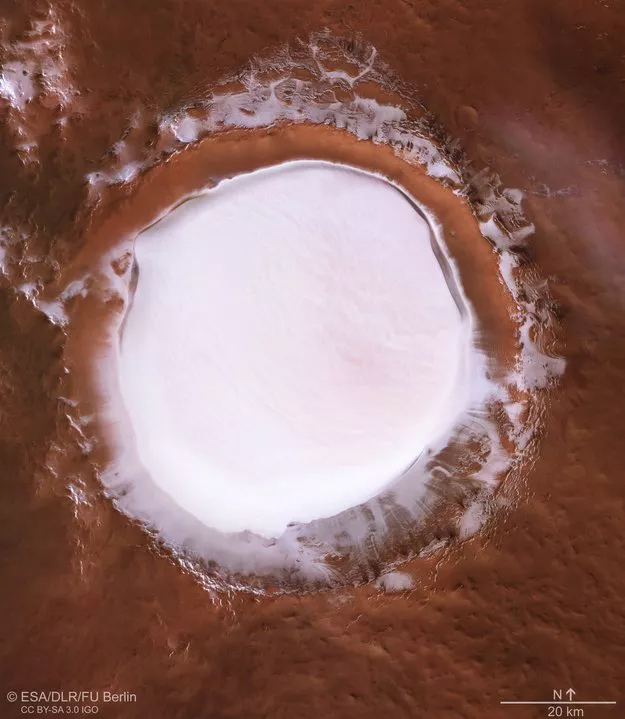Christmas card from Mars. The ESA showed a large accumulation of ice on the surface of the red planet.

Maybe you have already seen? Ice in the desert. This is not a photoshop and not a natural anomaly. These are new shots of water ice in Korolev crater on Mars, just published by ESA. They were made by the Mars Express satellite launched by the European Space Agency in 2003. The object weighing 666 kg has been rotating around the planet for 15 years, having repeatedly justified its cost of $ 345 million (by the way, it is two times cheaper than similar US satellites).
Recently, this "old man" made his most impressive pictures. The ESA publishes them in honor of the upcoming Christmas, the 50th anniversary of the Apollo 8 mission, which first flew to the Moon, and the 15th anniversary of the Mars Express rotation itself (he launched his main engine and entered Mars orbit on December 25).

Five shots at different times were taken with a HRSC camera , made specifically for Mars Express, and arranged in one image - allowing us to see what Korolev’s famous crater looks like in reality. In addition, topographic views of the object are also available .
The crater, named after the father of Soviet cosmonautics, is the most southerly point of the northern lowland of Mars, the Olympia Undae region , in which water ice still occurs. Its depth is 1.8 km, and it is almost filled to the top with ice, this is the southernmost such stable accumulation of ice on the planet. Here is its location on Google Mars.

The image of the same crater, taken by the CaSSIS system on the ExoMars Trace satellite in April 2018 (the first image of this satellite after launch). Visible here is a 40 km arc at the northern edge of the crater.
Ice in the crater did not pass into a gaseous state, apparently, several million years. Scientists from ESA cause this is the effect of "cold trap". The great depth of the crater and its steep edges cool the passing air. It descends with the dust and becomes part of the ancient ice deposits. And since there are no good conductors of heat in the rarefied atmosphere of the red planet, evaporation is minimal. Now the glacier has grown to colossal proportions: it occupies almost the entire area of the crater, 82 kilometers in diameter.
Is it worth panicking?
The new image of the ESA made a lot of noise. Some newspapers even came out with headlines a la "found water on Mars." Meanwhile, the presence of water in the form of ice on the surface of the red planet is not new for scientists. Mars has as many as two polar caps, ~ 300 and ~ 1000 kilometers in diameter, which we calmly distinguished hundreds of years ago with telescopes. Later, with the help of satellites, their composition was confirmed: water, dust and a large amount of carbon dioxide. Now we even have an idea about the amount of water on Mars. And for ten years now, we know that if we melt the northern and southern caps, this will be enough to cover the entire planet with a 20-meter layer of water (although CO 2 emissions will also increase atmospheric pressure on the planet twice).

Curiosity Labor Result
When researchers talk about finding water on Mars, they mean liquid water. In which, with a higher probability, even after millions of years, life could remain. The presence of underground oceans (at a depth of 1.5 km) was detected by the MARSIS radar on board the same Mars Express. In 29 photographs, scientists found an area where the signal changed dramatically - it looked like the subglacial lakes of Greenland and Antarctica.
The temperature of the underground water on Mars is probably also negative. But, as on Earth, the impurities in water and the pressure of a mass of ice can reduce its freezing temperature, so it remains liquid. But the hypothesis will need to be confirmed, and even better - to take samples. To do this, you will need a rover capable of drilling to such depths (which are generally not easy on Earth, either). Curiosity, launched by the United States in 2011, has so far drilled the surface of Mars to a depth of 5 centimeters.

